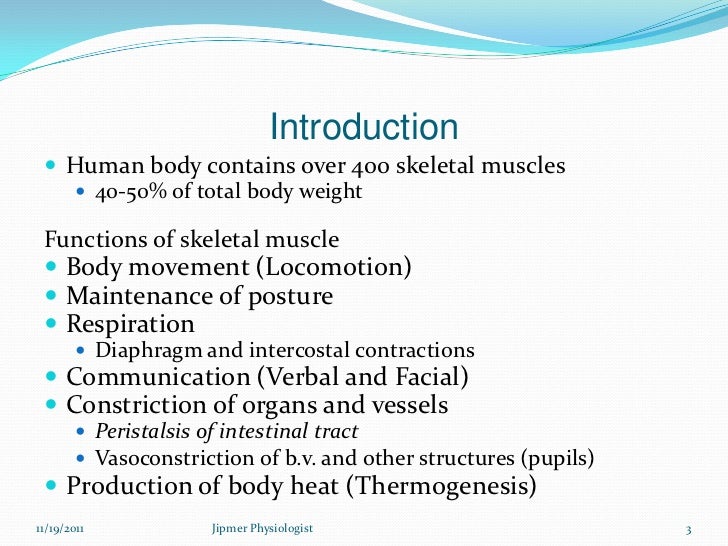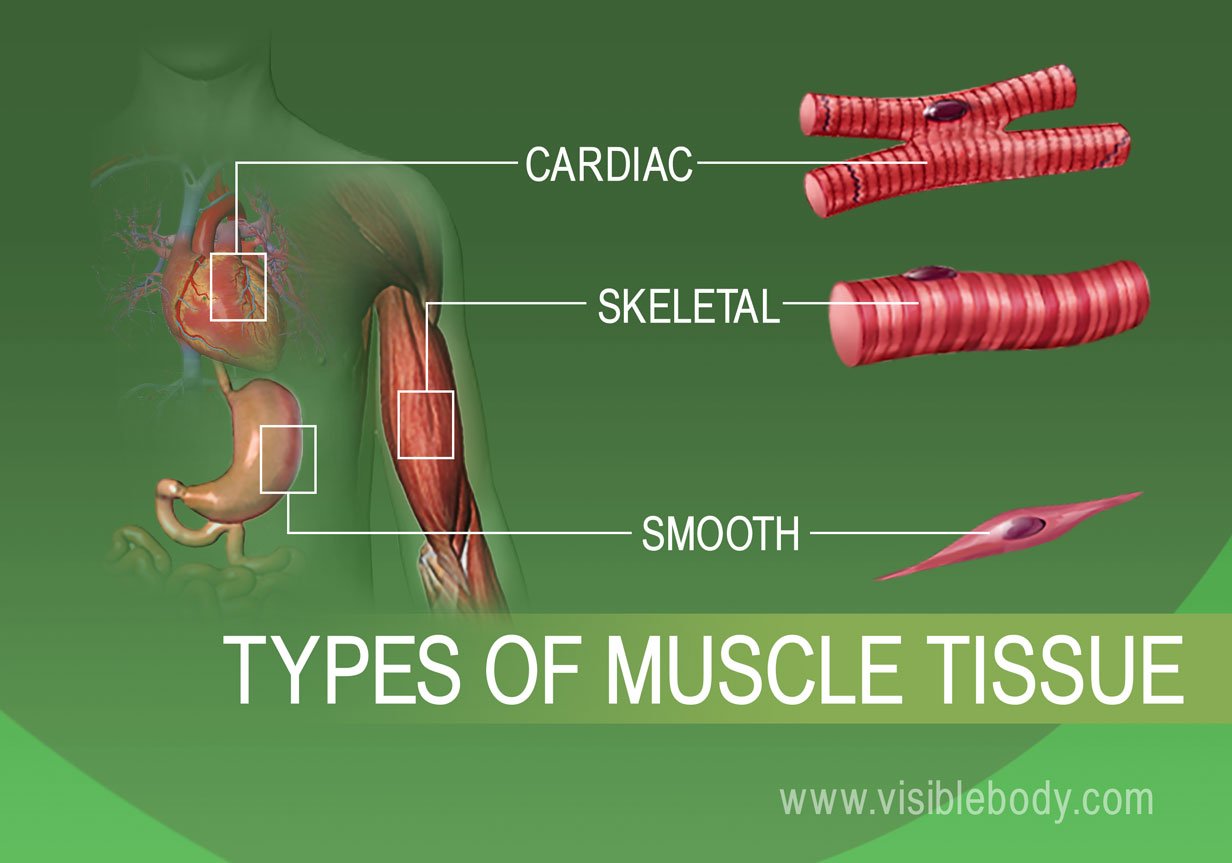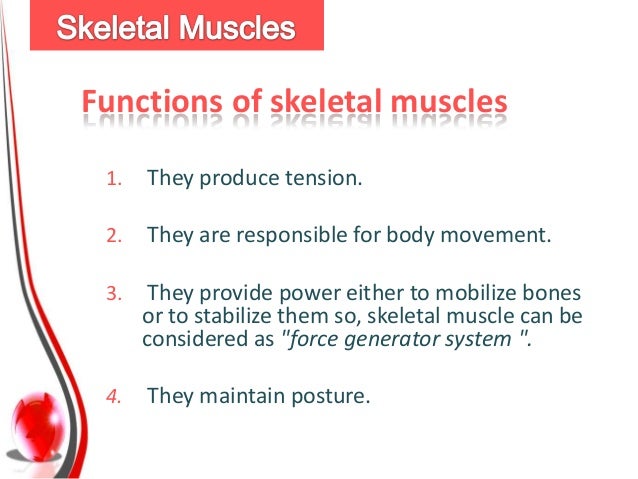It includes activities such. Learn vocabulary terms and more with flashcards games and other study tools.
:background_color(FFFFFF):format(jpeg)/images/library/13918/musculoskeletal-system.png)
Musculoskeletal System Anatomy And Functions Kenhub
9 Functions of the Muscular System 1.

4 functions of skeletal muscles. Start studying Four Functions of Skeletal Muscle. Physical movement of the human body is one of the many functions of skeletal muscles. The sartorius muscle in the thigh is the longest muscle in the body.
Skeletal muscle has four major functional characteristics. Opposing gravity and providing stability represent additional functions of skeletal muscles. The gluteal muscle is responsible for the erect posture of.
Skeletal muscle has four major functions these are. Additionally skeletal muscles help. For example the gluteal muscle also helps one stand up and maintain the erect posture.
Skeletal muscle is a specialized contractile tissue found in animals which functions to move an organism s body. Skeletal muscles are attached to your. By Staff Writer Last Updated Mar 28 2020 60708 AM ET.
Excitability ek-sıÂtă-bili-tē is the capacity of skeletalmuscle to respond to a stimulus. Skeletal muscle structure and function The muscle system is responsible for movement of the human body posture movement of substances inside the body andfor the generation of body heat. Skeletal muscle is comprised from a series of bundles of muscle fibers surrounded by protective membranes.
The involuntary cardiac and smooth muscles help your heart beat and blood flow through your body by. Skeletal muscle is responsible for generating the force needed to move the body. Skeletal muscles commonly called muscles are mostly composed of striated muscle tissue.
In skeletal striated muscle tissue the muscle cells are known as muscle fibersSkeletal muscles are voluntary muscles under the control of the somatic nervous systemThe other types of muscle are cardiac muscle which is also striated and smooth muscle. The skeletal part plays an important role in other homeostatic functions such as storage of minerals eg calcium and hematopoiesis while the muscular system stores the majority of the bodys carbohydrates in the form of glycogen. A skeletal muscle is an organ in the muscular system.
The skeletal muscle refers to the muscle that moves the bones and supports the skeleton due to the movement of living organisms. It controls body movement and is performed consciously. The human muscular system.
The multifidus muscle of the lumbar region helps extend and laterally flex the vertebral column. The semispinalis muscles include the semispinalis capitis the semispinalis cervicis and the semispinalis thoracis. The skeletal muscles of the ribs and abdomen are responsible for the.
Connective tissue sheath that surrounds the individual muscle fibers tendon cord like bunch of dense fibrous connective tissue that connects muscle to bone avascular. There are approximately 700 known and named muscles and on top of that muscle tissue is also found inside of the heart digestive organs and blood vessels. The body posture is maintained by the skeletal muscles.
Force generation for breathing respiration. The skeletal muscles are responsible for body movements such as typing breathing extending the arm writing etc. The bones act as levers and also form joints that allow muscles to.
This muscle along with four other muscles. Contractility kon-trak-til i-tē is the ability of skeletal muscle to shorten with force. Our skeletal muscles serve a variety of functions.
Students can learn more about skeletal muscle here including its structure functions and examples. Besides its main function to provide the body with stability and mobility the musculoskeletal system has many other functions. Skeletal muscle is the only voluntary muscle group in the body.
Your skeletal muscles are responsible for the movements you make. Contractility excitability extensibility and elasticity. Through contraction and relaxation skeletal muscles help to support and move our body.
Force generation for movement. The four primary functions of the skeletal system are to support muscles and tissue protect the vital organs allow movement of bones and muscles and serve as the storage center for immature blood cells and minerals. Following are the important skeletal muscle function.
Some of the movements skeletal muscles are responsible for include smiling lifting and sitting. The skeletal muscles helps one maintain their body posture. Movement the skeleton allows movement of the body as a whole and its individual parts.
The bodies of living organisms contain different types of muscles like the skeletal smooth and cardiac muscles.

Skeletal Muscle Structure Function

6 1 The Functions Of The Skeletal System Anatomy Physiology

Skeletal Muscle Structure Function

Skeletal Muscle Functions Ppt Video Online Download

The Muscular System Ppt Download

Interactions Of Skeletal Muscles Anatomy And Physiology I

7 The Muscular System Ppt Download

Skeletal Muscle Unit Chapter 6 Functions Of Skeletal Muscles Produce Skeletal Movement Maintain Posture And Body Position Support Soft Tissues Ppt Download

Skeletal Muscle Structure And Function Musculoskeletal Genetics

Muscle Tissue Types Learn Muscular Anatomy

Muscle Physiology Distinguish Between The 3 Types Of Muscles And Describe The Four Main Functions Of Muscles Ppt Video Online Download
Skeletal Muscle Functions Gross Anatomy Flashcards Draw It To Know It

